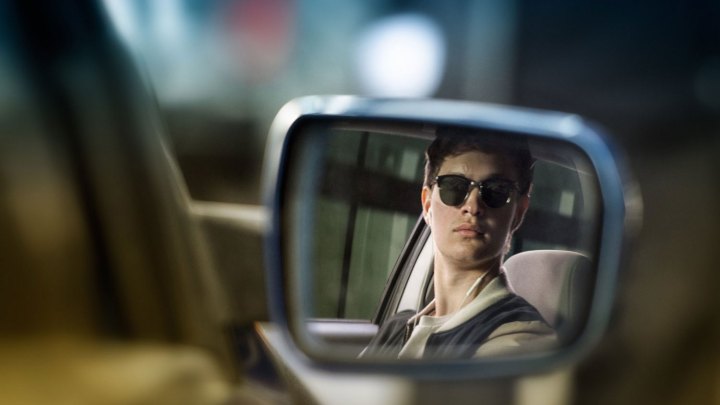Shaun of the Dead and Hot Fuzz director Edgar Wright takes on the crime genre in his latest movie. Read on for our Baby Driver review.
Every now and then a movie comes along that not only captures your attention with an original premise and intriguing trailer, but also manages to follow through on all of that potential with an impressively executed film that saves its best moments for the ticket-buying audience.
Director Edgar Wright’s music-fueled crime thriller, Baby Driver, is all that and more.
Written and directed by the Shaun of the Dead and Hot Fuzz filmmaker, Baby Driver casts The Fault in our Stars actor Ansel Elgort as “Baby,” a supremely talented getaway driver employed by a calculating criminal mastermind. Baby’s childish features earned him his nickname, but it’s his prodigious skills as a wheelman that have made him the favorite driver for crime boss “Doc,” portrayed by two-time Academy Award winner Kevin Spacey. Pulled back into the heist game after he thought he was out for good, Baby finds himself on the run from the police and a colorful assortment of criminals when a job goes awry.
If Baby Driver was simply a crime film, it would be a thoroughly entertaining, if somewhat eccentric, entry in the genre. What it actually is, though, is a brilliant blending of music, mood, story, and perspective that’s much more than the sum of the genres that inspired it.
Elgort’s character lives with a near-constant soundtrack to his life, made possible by an array of iPods corresponding to his moods and missions, and made necessary by a chronic case of tinnitus that makes music the only thing capable of drowning out the ringing in his ears. The audio cocoon he creates for himself allows him to both focus and function in the world, and it’s as important to Baby as it is to the film itself, which runs hot on an eclectic mix of songs from the last half-century of music.
Wright’s vision takes the film to the next level.
Much has been made of the movie’s use of music in the lead-up to its release, but this aspect of the film is no gimmick.
Where recent films like Marvel Studios’ Guardians of the Galaxy (and the sequel from that motley bunch of a-holes — their term, not ours) earned praise for bringing fresh attention to classic songs that served as the backdrop to the on-screen action, Wright makes the music of Baby Driver as integral to the movie as its dialogue or anything that occurs on the screen. Motown, proto-punk, alt-rock, and various other musical genres are the fuel in the engine of Baby Driver, and Wright shows an expert driver’s command of his vehicle.
Like that old urban myth about listening to Pink Floyd’s Dark Side of the Moon album while watching The Wizard of Oz, the action on the screen unexpectedly synchronizes with the music playing in Baby’s headphones at various points throughout Baby Driver. Wright fuses the sound of a gunshot with the percussion in a Queen song in one moment, then amplifies a guitar solo with a well-timed screech of tires, only to eventually let the drumroll from another track add the punctuation to a tense line of dialogue.

At times, the merging of the soundtrack and the on-screen action in Baby Driver is so subtle that it comes as a pleasant surprise when you suddenly realize the two elements are running in parallel; at other times it’s a conscious, self-aware arrangement that plays to the film’s narrative with Baby and the events unfolding around him.
Although it’s Wright’s vision for the film that takes it to the next level, Baby Driver isn’t short on memorable performances, either.
Elgort takes a little while to warm up as the title character, but eventually finds a good idling point as a sympathetic if somewhat quirky protagonist. His portrayal of Baby takes ample cues from the many versions of the archetype that came before it — Ryan O’ Neal’s iteration of the character in 1978’s The Driver, for example — but he does an admirable job of giving the character a depth that few of those wheelmen ever had.
The musical aspect of the film is no simple shtick.
Spacey brings a level of menace to his role as the kingpin employing Baby that makes him one of the film’s scariest characters simply by the implied threat he presents. On the flip side, Jamie Foxx reaches a similarly high threat level by going all-in on his bank-robbing character’s knack for unpredictable violence.
The two aforementioned characters offer a wide, entertaining range of dangerous elements in Baby’s life, and the rest of the threats he faces — among them criminals played by Jon Hamm, Jon Bernthal, Eiza González, and Flea — fill in the gaps between those two extremes.
Wright also holds his own as a director of chase sequences, and offers up some set pieces that rival the best of some of the genre’s landmark automobile pursuit scenes. The film’s first major getaway sequence compares favorably to anything found in Drive, Ronin, or The Driver, for example — all films held in high regard for their chase sequences.

In many ways, Baby Driver is as much a musical as it is an action-packed crime film. But in blending the two genres to the point where it’s unable to see where the influence of one ends and the other begins, Wright’s film manages to be something truly unique. At a time when remakes, reboots, and sequels dominate the movie calendar, Baby Driver stands apart from the crowd with a fresh experience that’s as ambitious as it is entertaining.
Wright makes beautiful music on the big screen with Baby Driver, and you simply can’t help singing along with it.







